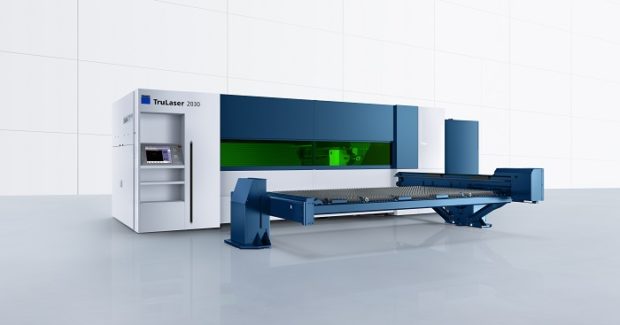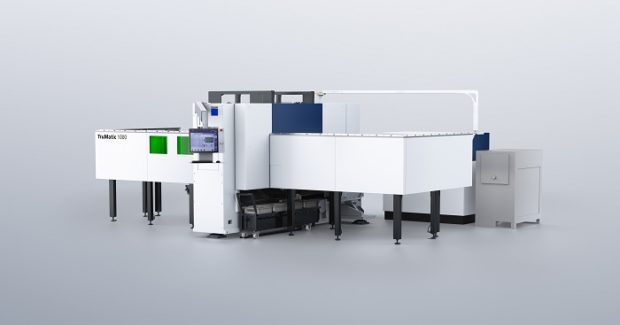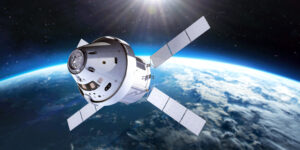The World’s Fastest Automated Bending Cell for Appliance Manufacturing
The TruBend Cell 7000 from TRUMPF is comprised of a TruBend 7036 Cell Edition press brake, a BendMaster bending robot, a LoadMaster Bend material handling unit, a pallet system and tracks, all within an enclosure that requires only 69 sq ft of floor space.
Posted: April 11, 2018
The TruBend Cell 7000 from TRUMPF Inc. (Farmington, CT) is the world’s fastest system for the automated bending of small parts in either short or long production runs for appliance manufacturing. With an average cycle time of four seconds per bend, it delivers parts twice as fast as conventional bending cells. This cell is comprised of several components: a TruBend 7036 Cell Edition press brake, a BendMaster bending robot, a LoadMaster Bend material handling unit, a pallet system and tracks, all within an enclosure that requires only 69 sq ft of floor space. The highly dynamic TruBend 7036 Cell Edition features a press force of 40 tons and an electric torque motor for high speed acceleration. Intelligent back gauges built from lightweight materials enable parts to be positioned quickly, to achieve a maximum pressing speed of 2 in/sec. The innovative ram is divided into two 20 in sections to provide clearance for the grippers on the BendMaster. With extreme precision and repeatability, these grippers can position components with a sheet thickness up to 0.3 in.
The LoadMaster Bend’s multi-vacuum gripper prepares the bending part parallel to the current bending operation. A high speed vision system identifies the exact orientation of the blanks. The flexible loading arrangement allows for up to 24 different blanks or 4,800 parts to be accurately delivered to the machine. The standard system configuration includes unloading of finished parts to boxes or bins. Alternatively, the system can be equipped so scratch-prone parts are individually unloaded to a conveyor belt. The TruBend Cell 7036 Cell Edition, BendMaster and LoadMaster Bend are expertly coordinated to achieve a cycle time of 4 seconds per bend using TruTops Bend programming software. Offline programming supports and optimizes the tool selection, bending sequences and precise gripping position. Algorithms determine the shortest traverse paths to reduce the time per bend.
As an option, the ToolMaster Bend can be implemented to change bending tools as part of the automated process. This is particularly useful for small batches because the cell can process the different orders without an operator. The BendMaster uses the ToolMaster Bend to select the appropriate tools without having to change grippers. Reading an ID chip inside the tool, the integrated Tool Identification System (TIS) automatically identifies the tool type and position and communicates the data to the controller in the tool clamp and in the support tracks of the ToolMaster Bend. The TruBend Cell 7000 is ideal for all industries that process small blanks in either short or long production runs, including electronics manufacturers, HVAC and electrical equipment builders, as well as food service and agricultural OEMs. Contract manufacturers can also benefit from the ability to process diverse small parts with high productivity and unmanned operation.
For other shops, TruBend Series 7000 precision press brakes are compact machines that offer a high quality, efficient system for producing small bent parts up to 40 in. Typical applications include sheet metal parts used in the production of vending machines, electrical equipment, telecommunications and aerospace industries, where bending such parts with large, heavy press brakes is typically inefficient. The TruBend 7036 is the world’s most ergonomic press brake. Optimum working conditions and user-friendly operating elements are integrated into the machine design. The operator can control the machine while sitting down, and work without becoming fatigued, which helps ensure the quantity and quality of the fabricated parts. Gas spring supported pedals allow the height and angle of the foot rests to be adjusted. The arm support is also adjustable enabling every operator to set the workplace to his or her individual preference.
In addition, the monitor for the TASC 6000 control system of the TruBend Series 7000 can be adjusted electronically and set to the appropriate angle. Optional LED lighting illuminates the area in front of and behind the beam, ensuring correct lighting conditions precisely at the bend, without heat radiation. An optional laser diode also projects the bend line onto the surface of the sheet metal, simplifying the accuracy of guiding the workpiece into the back gauge.
To meet the needs of shops that are entering into laser cutting, the intuitive operation and low operating costs of the highly productive TruLaser 2030 fiber provides 4 kW of laser power and optional automation in a remarkably productive laser cutting machine that requires only 25 ft x 20 ft of floor space, including pallet changer. Important components, such as the switch cabinet, suction system and laser, are built into the machine frame. The 5 ft by 10 ft working area is easily accessible along its whole length. Large windows and LED illumination provide optimal viewing inside the machine and the design ensures complete safety from the laser. The machine’s self-guided control meets the needs of newcomers to laser cutting, guiding the operator through setting up and programming the machine right on the control user interface until the program is ready to start.
Cutting parameters for all materials and sheet thicknesses are stored on the machine prior to delivery. Along with its intuitive operation, this significantly reduces the amount of operator training required. Cutting programs can be easily transferred to the TruLaser 2030 fiber using a network connection or USB drive. Drawings can be created almost instantly directly on the machine and converted into cutting programs. The TruLaser 2030 fiber is available with 2 kW, 3 kW or 4 kW of laser power and displays its strengths in sheet thicknesses from 0.04 in to 0.5 in, where it cuts very fast. It also processes thicker sheets. Thanks to the robust TruDisk solid state laser, the TruLaser 2030 fiber can even cut highly reflective materials, such as copper, using nitrogen. All materials and sheet thicknesses can be processed with the same cutting unit. This saves setup time because there is no need to change the lens and cutting head.
Along with other parameters, the focal position of the laser also adjusts automatically to the respective material. The cutting head’s collision protection and an automatic nozzle changer with space for eight nozzles reduce setup times even further. Depending on the capacity utilization and the degree of automation desired, the machine is available with a pallet for manual loading and unloading, a pallet changer or a retrofittable LiftMaster Shuttle that makes it possible to load and unload the machine fully automatically. Available in many different configurations, the TruLaser 2030 fiber adapts perfectly to any material flow and space requirements.
The various laser power options and material flow systems permit different application scenarios: Equipped with 2 kW of laser power and a manual pallet, the TruLaser 2030 fiber works cost effectively even at lower utilization rates. The combination of 3 kW of laser power and a pallet changer increases application flexibility and productivity. Thanks to the increased laser power, it is possible to process thicker sheets. Using the pallet changer, the machine works efficiently in one- or two-layer operation; material changes take only 45 seconds. Meanwhile, the system with 4 kW of laser power, automatic nozzle changer and LiftMaster Shuttle is ideally suited for continuous operation. To increase the capacity utilization of the laser and gain economies of scale, the machine can also be operated in a laser network that takes advantage of the additional output available on the TruDisk Laser. In a laser network, the laser source can supply a second machine or welding cell, as well as the TruLaser 2030 fiber.
TRUMPF also offers an economical, compact and automation-friendly punching machine that is specifically designed to grow with a shop’s business: the TruMatic 1000 fiber punch laser machine with a working range of 5 ft x 10 ft provides expandable functionality that makes it the perfect machine for entry into precision punching. It can handle sheets up to 0.25 in thick at rates of up to 600 spm, yet is remarkably compact. With a footprint of just 21 ft x 12 ft, it is approximately 15 percent smaller than its predecessor. The machine enables fabricators to process medium-format sheets without repositioning for significantly faster production overall. The machine’s unique modular design enables the TruPunch 1000 to transition into the new TruMatic 1000 fiber, a combination punch laser machine. This transition is achieved by adding a 3 kW TruDisk solid state laser and retrofitting the TruPunch 1000 with a laser cutting system, a laser evacuation unit and a beam guard system. Through this conversion process, sheet metal fabricators are able to increase the variety of parts they manufacture.
Shops with an existing TruDisk solid state laser also have the added flexibility of connecting to the TruMatic 1000 fiber via the TRUMPF laser network. With a low cost of entry, these fabricators are able to easily switch from strictly 2D laser cutting to punch laser processing. Both new machines offer a completely redesigned drive technology that is crucial to the success of the modular concept. The patented “Delta Drive” moves both the electric punching head and the laser along the Y-axis while the sheet moves in the opposite direction – a revolution in punching head technology. Powered by two servomotors, this arrangement enables the machine to accelerate far faster in the Y-axis and eliminates the need to move the sheet or work table. As a result, the punching process is more dynamic and the machine is more productive than with the previous design.
Decreasing relative movement between the machine table and the metal sheet also reduces the risk of collisions and makes the process more reliable overall. In addition to machine dynamics, productivity and process stability, this new approach facilitates a significantly compact footprint. Both the TruPunch 1000 and the TruMatic 1000 fiber are designed to automatically sort finished parts up to 7 in x 7 in. Processed parts are sent down a chute and can be sorted into a series of four boxes (16 in x 12 in). The boxes are positioned below the machine for easy removal. Alternatively, an additional extra-large flexible parts flap, a standard feature of the TruMatic 1000 fiber and an option for the TruPunch 1000, provide users with a second choice for part sorting. Equipped with a sensor that detects whether all the parts have been properly ejected from the machine’s working area, this system can be used to eject long and wide parts into containers as well as onto conveyors or pallets during both the punching and laser operations. The machine simply ejects the parts through the generously sized flap and places them straight in the container.
As the first entry-level combination machine from TRUMPF with a solid-state laser, the goal was to make the TruMatic 1000 fiber compact as possible. For this reason, a special space-saving beam guard system was developed that is compatible with the machine’s modular concept. The machine’s protective housing, a requirement for safe laser processing, is integrated into the system and features two laser safety windows that allow users to visibly monitor laser cutting. This protective housing automatically moves out of the way when the machine is punching to give operators maximum visibility and accessibility.
The new TruPunch 1000 and TruMatic 1000 fiber are more compact than any other comparable machines on the market, even when configured with automated handling. Both can be connected to the new SheetMaster Compact, an automation system that is designed to load small to medium sized sheets and blanks and unload microjoint sheets and scrap skeletons. Optimized loading cycles makes it possible to complete most of these tasks while the machine is in operation. Both machines are also equipped with an intuitive touchscreen for easy operation, and are compatible with the MobileControl for remote operation from a tablet. The machines come equipped with the TruTops Boost Punch software for maximum ease in programming.
TRUMPF Inc., 111 Hyde Road, Farmington Industrial Park, Farmington, CT 06032, 860-255-6039, www.us.trumpf.com.














